Business
Tesla to slash more than 10% of its global workforce

Tesla Inc. is laying off more than 10% of its workforce, Chief Executive Elon Musk wrote in an email to staff.
Musk cited job overlap and the need to reduce costs, according to the email sent late Sunday. Bloomberg News estimated that the layoffs would affect more than 14,000 employees.
“As we prepare the company for our next phase of growth, it is extremely important to look at every aspect of the company for cost reductions and increasing productivity,” Musk wrote in the email viewed by The Times.
“As part of this effort, we have done a thorough review of the organization and made the difficult decision to reduce our headcount by more than 10% globally,” he continued. “There is nothing I hate more, but it must be done.”
The reduction comes as the Austin, Texas-based carmaker and its rivals contend with less demand for electric vehicles in a crowded field.
“It’s an ominous sign of some dark days ahead,” said Dan Ives, managing director at Wedbush Securities. “Streamlining is one thing, but the size of this cut is a concern for a company that’s still in growth mode.”
Although Tesla moved its headquarters from California to Texas in 2021, it still operates a massive factory in Fremont that is one of the largest manufacturing sites in the state.
In January, Tesla reported disappointing fourth-quarter earnings that included its first year-over-year decline in quarterly deliveries in four years. Revenue and earnings per share also missed estimates.
Industry sales have slowed amid higher interest rates that have made the costly cars more expensive and have increased the challenges of expanding the market beyond the affluent first adopters who made Tesla one of the most highly valued companies in the world.
Earlier this year, Manhattan Beach-based Fisker Inc. announced it was cutting 15% of its 1,200-person workforce, halting production for six weeks and working on a deal for $150 million in new financing, dependent on forging a strategic relationship with a major auto manufacturer.
However, it was unable to obtain the financing after talks ended with the manufacturer.
Lucid Motors, a Newark, Calif.-based maker of luxury sport utility vehicles and sedans, got a $1-billion cash infusion in March from its biggest backer, an affiliate of Saudi Arabia’s Public Investment Fund. In February, Apple announced it was ending development of a self-driving electric vehicle after reportedly spending more than $10 billion on the project over a decade.
On Monday morning, Drew Baglino, Tesla’s senior vice president of powertrain and energy, announced on X, formerly Twitter, that he was leaving the company.
“I made the difficult decision to move on from Tesla after 18 years yesterday,” he wrote. “I will always have a warm spot for the people of Tesla and Tesla products in my heart and wish the team and company the best in the future.”
In a reply, Musk wrote: “Thanks for everything you’ve done for Tesla. Few have contributed as much as you.”
Tesla’s stock Monday closed at $161.48, down nearly 6%. The company is scheduled to report first-quarter earnings April 23.
“Investors need answers from Musk on next week’s call because it’s been a string of bad news,” Ives said. “I consider it a fork-in-the-road period for Tesla and Musk. It was a Cinderella story for years, but now it’s turned into a scene out of the ‘Thriller’ video.”
Times staff writers Russ Mitchell and Laurence Darmiento contributed to this report.

Business
California climbers train for Mt. Everest from the comfort of their own beds

Graham Cooper sleeps with his head in a bag.
Not just any bag. This one has a hose attached to a motor that slowly lowers the oxygen level to mimic, as faithfully as possible, the agonies of fitful sleep at extreme altitude: headaches, dry mouth, cerebral malaise.
“It’s not all bad,” Cooper insisted, nodding to the humming motor. “That’s like white noise.”
Cooper, 54, an Oakland biotech executive who has handled finance for a number of companies, including one that sold for $7 billion, isn’t a masochist, exactly. He’s acclimatizing, in the bedroom of his second home near Lake Tahoe, for an attempt to climb Mt. Everest in May.
Graham Cooper uses a pulse oximeter to check his blood oxygen levels and pulse rate at his Truckee home.
He has signed up with an Olympic Valley-based guide service whose founder, Adrian Ballinger, is breaking with decades of tradition to create what he believes are better and more ethical ways to climb the world’s tallest mountain.
Ballinger said he was appalled by the risks, filth and ballooning crowds on the traditional southern trek up the mountain in Nepal. That’s the route familiar from countless documentaries and books, including the 1997 classic “Into Thin Air.”
So he decided to take clients up on the north side, a journey that starts in Tibet.
“It’s colder, the route is more difficult, and the bureaucracy of dealing with China and getting the permits is a complete nightmare,” Ballinger said. “But despite those things, the Chinese are attempting to regulate, so once you get on the mountain, it’s safer, it’s cleaner, and it’s much less busy.”
Ballinger is also pioneering a technique he calls “rapid ascent,” which cuts the duration of the expedition roughly in half: from about two months to about one. That suits his clients, who usually have more spare money than time. And it buys Ballinger more time to spend at home with his wife and newborn son.
The catch? You have to spend a few months before the trip with your head in the bag.
“It’s not great, I’m not gonna lie,” Ballinger said with a laugh, but the technology is improving.

Graham Cooper has been diligently training for his Mt. Everest climb, a regimen that includes skiing laps up and down the slopes near his Truckee home.
(Brian van der Brug / Los Angeles Times)
“Hypoxic tents,” as they’re called, have been used by other endurance athletes for years. In their original form, they would cover a client’s entire bed. That led to difficult conversations with spouses and partners about the necessity of sleeping at progressively higher simulated altitudes until they reached the height of Everest’s base camp, roughly 18,000 feet, where there’s about half the oxygen available at sea level.
As you can imagine, some clients wound up relegated to a couch with their bizarre-looking contraptions.
Cooper, who used one of the enormous old tents preparing for a 2015 trip to climb the highest peaks in Antarctica and South America, confessed he had no luck sweet-talking Hilary, his wife of 28 years, into sharing the adventure. He got bounced to a guest room.
“It was a lonely boy-in-the-bubble experience,” he said. But he has fond memories of the looks on his kids’ faces as they trooped into his little dungeon to kiss him good night.
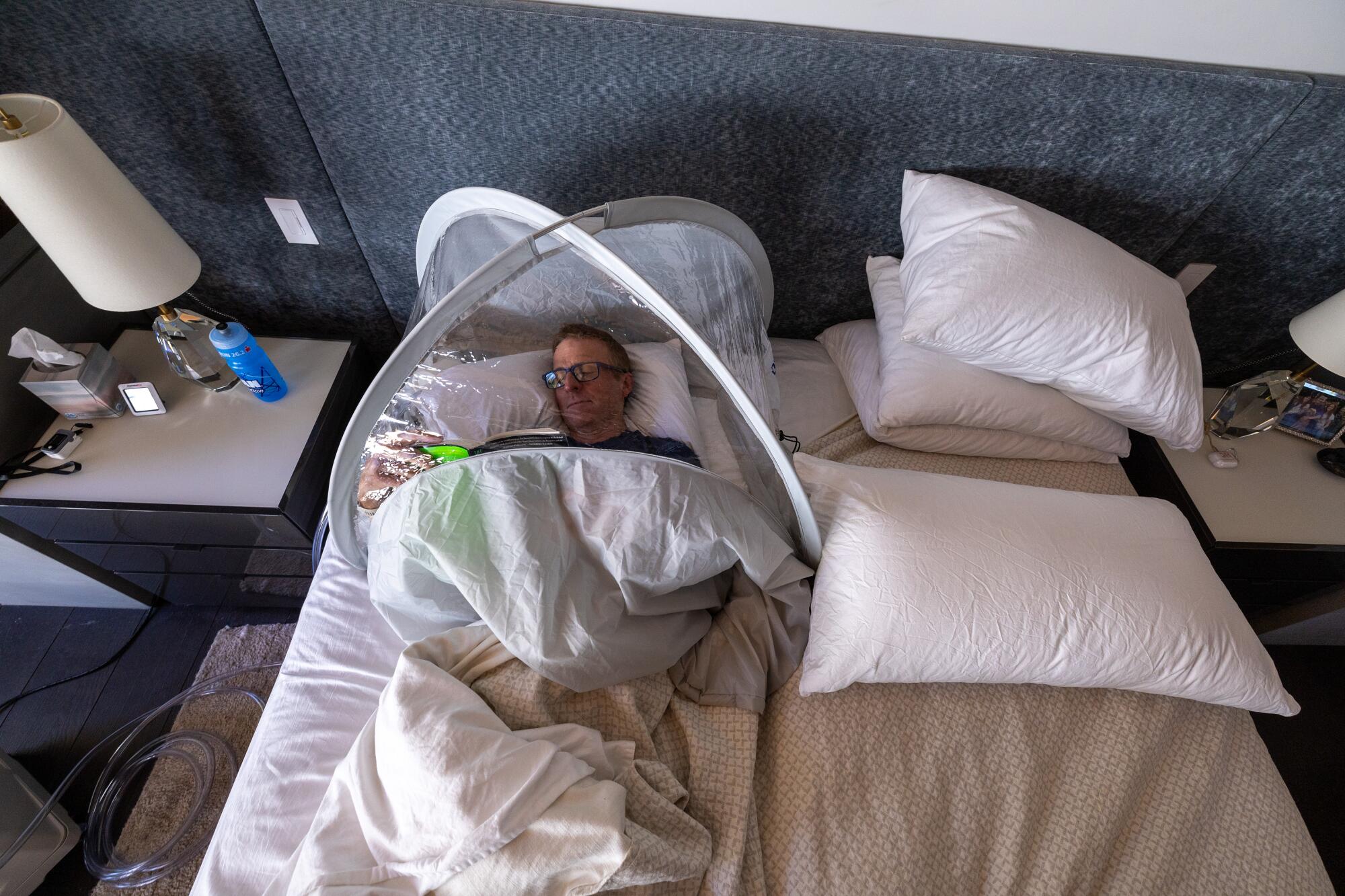
Graham Cooper relaxes with a book inside an hypoxic tent that slowly lowers the oxygen level to mimic conditions at extreme altitude.
This time around, “the bag,” as he calls it, covers just his head and upper torso and takes up about a quarter of the bed. Hilary sleeps next to him, Cooper said, and she finds the hum of the motor surprisingly soothing.
It goes without saying that the luxury of acclimatizing at home, in bed, with your partner curled up beside you, represents a profound break from the usual manner of preparing to ascend what is still one of the world’s deadliest mountains.
The traditional method starts in Kathmandu, at nearly 5,000 feet, where climbers spend a few days getting over jet lag. That’s usually followed by a quick flight to the small mountain town of Lukla, at just over 9,300 feet. The airport there — perched on a narrow Himalayan shelf surrounded by towering peaks, with a steep drop-off at the end of the runway — is regarded as one of the trickiest places in the world to land an airplane.
From there, climbers begin a long, deliberately slow 10-ish-day hike to base camp. The point is to give the body time to gradually adjust to the lack of oxygen.
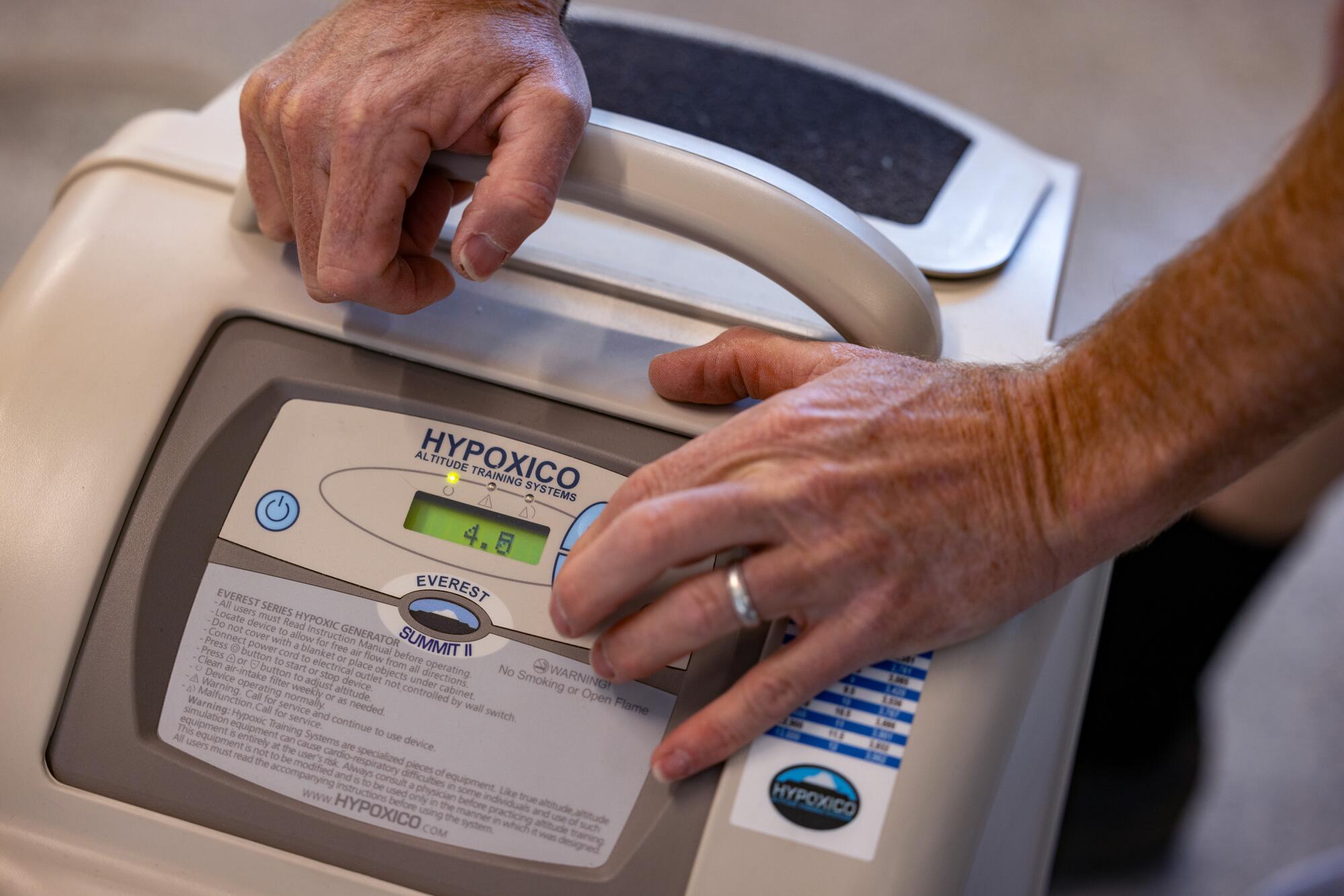
Mountain guide Adrian Ballinger says employing technology that allows clients to acclimatize to high elevations at home has allowed him to cut weeks off their expeditions to Mt. Everest.
Ballinger cuts nearly two weeks from his trips by driving his bedroom-acclimatized clients from the airport in Lhasa, Tibet, straight up to the northern route’s base camp, which is also at about 18,000 feet.
For some old-school purists, eliminating the long walk borders on sacrilege, said Will Cockrell, a journalist whose recent book, “Everest, Inc.,” explores the evolution of commercial guiding on the mountain. “They’ll say, ‘You’re not a real climber; you’re not a real nature lover,’” Cockrell said.
But since the arrival of big commercial expeditions on Everest in the mid-1990s — complete with Sherpas to install climbing ropes, chefs to cook meals in camp, team doctors to monitor health, and guides to accompany clients every step of the way — Mt. Everest has ceased to be a classic off-the-grid mountaineering challenge.
“It has come to represent something completely different,” Cockrell said, “something crazy to do to shake up your life, like running an Ironman.”
Ballinger makes no apologies. “We’re not old school, we don’t spend a lot of time sitting around drinking whiskey and playing cards,” he said.
That suits his clients, who “tend to be pretty type A, pretty high performing in everything they do,” Ballinger said.
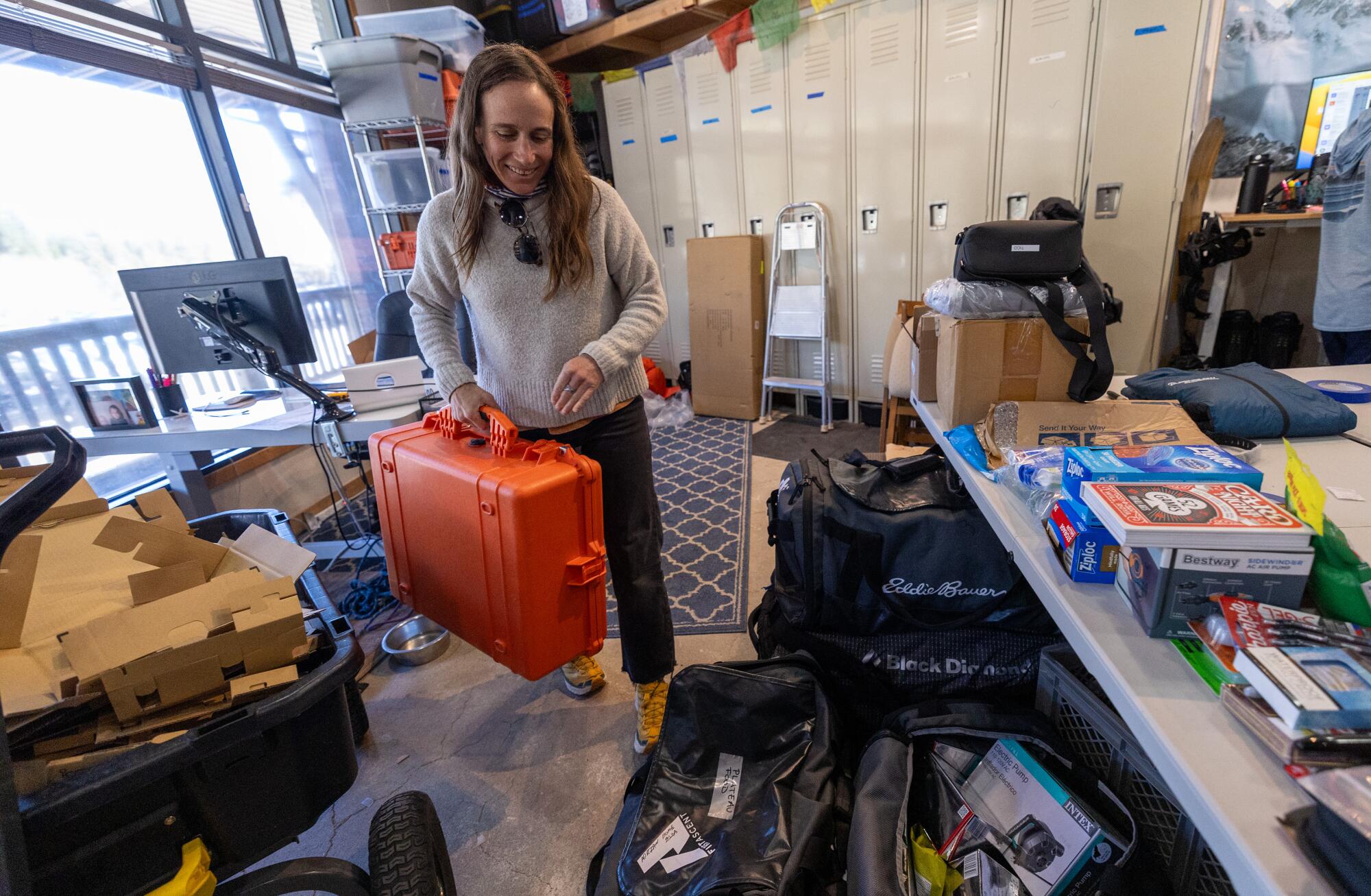
Emily Turner, Alpenglow Expeditions’ Everest base camp manager, organizes supplies for a May trip.
They’d better be. His company, Alpenglow Expeditions, charges $165,000 (before tip) for a private climb, meaning one professionally certified guide per client, and $98,000 for a group climb with three clients per guide.
“We’re proudly expensive,” Ballinger said. “I’ve spent a lot of time thinking about what it takes to run a trip safely and ethically, and this is what it takes.”
Climbing from the north side, as Ballinger does, avoids the huge crowds who flock to the southern base camp from all over the world every May, the prime climbing season on Everest, to wait for a brief window of good weather to try to make it to the summit.
Anyone who has even loosely followed events on Mt. Everest in recent years is probably familiar with the terrifying “conga line” photos of climbers stuck in the world’s highest traffic jam.
It forms just below the summit on the southern route, at the last technical obstacle, a nearly vertical 40-foot rock wall called the Hillary Step. It’s on a ridge with a 10,000-foot drop to the climber’s right and an 8,000-foot drop to the left. So, when exhausted and inexperienced climbers inevitably struggle there, everybody else waits in a single file, hanging onto a fixed rope, while the bottled oxygen they need to survive at that altitude slowly drains away.
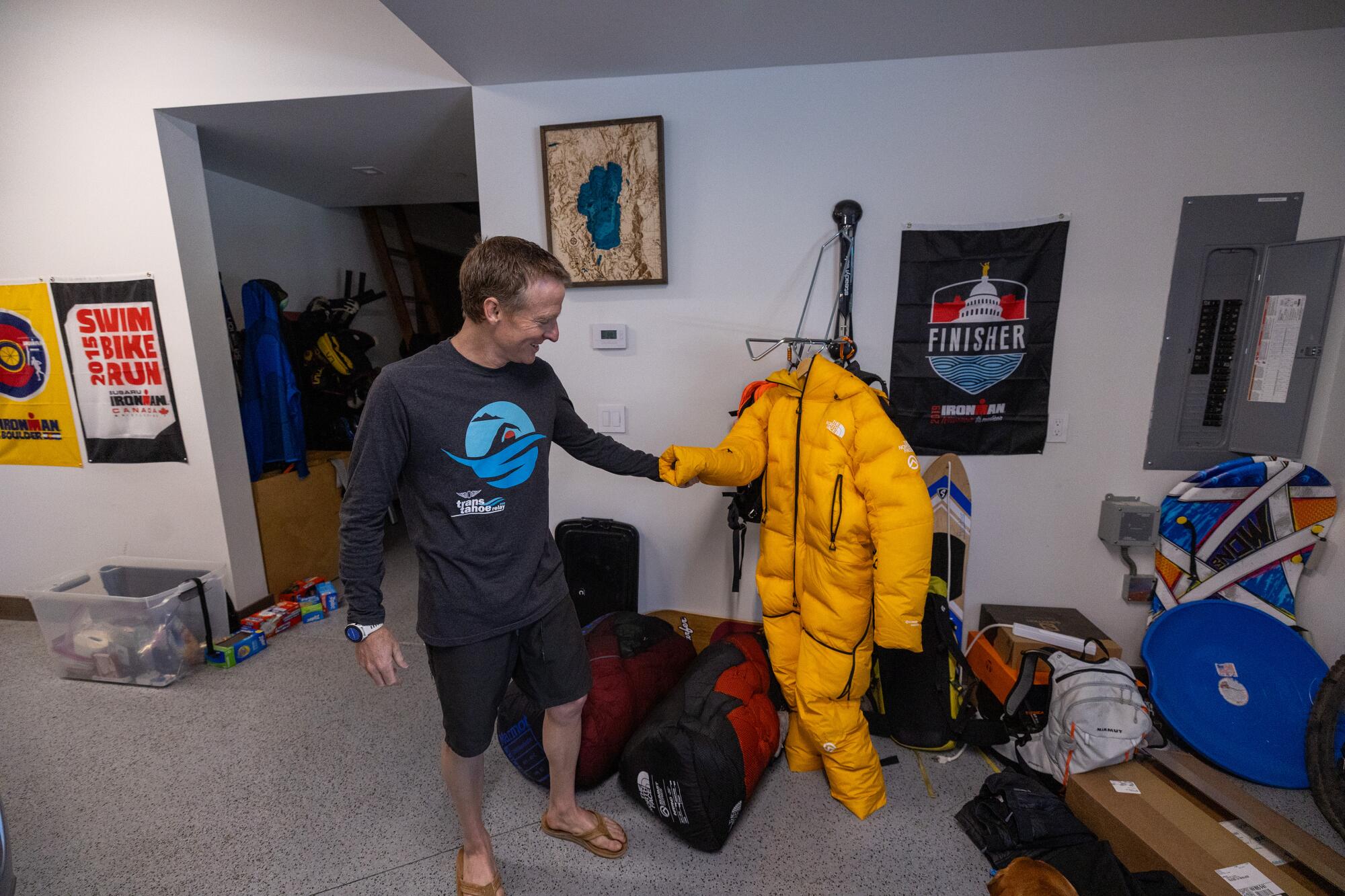
Graham Cooper is no stranger to grueling physical challenges. He has competed in the Ironman World Championship 11 times and has won the 100-mile Western States Endurance Run.
Worse is the Khumbu Icefall, a glacier just above the southern base camp. It’s best known for wide spine-tingling crevasses spanned by flimsy-looking aluminum ladders lashed together with rope. Climbers have to walk across those ladders, wearing big boots and crampons, as they make multiple trips back and forth to advanced camps to acclimatize before finally heading for the summit.
As dangerous as it is for the mostly foreign climbers and guides, the odds are even worse for the local Sherpas, who regularly traverse the Khumbu ferrying equipment — tents, food, oxygen canisters — for the climbing teams. Last year, the deadliest climbing season in Everest history, three Sherpas were killed in the Khumbu when a towering block of ice collapsed and buried them.
In six seasons climbing the southern route, from 2009 to 2014, Ballinger said he passed through the Khumbu 38 times and had two close calls. While nobody on his teams lost their lives there, he helped recover the bodies of other climbers who had not been so lucky.
Finally, he did the math and concluded there was no way he could get through a whole career — 20 or 30 years — without losing someone he was responsible for in the Khumbu.
“I just couldn’t do it anymore,” Ballinger said. “I just couldn’t justify the risk.”
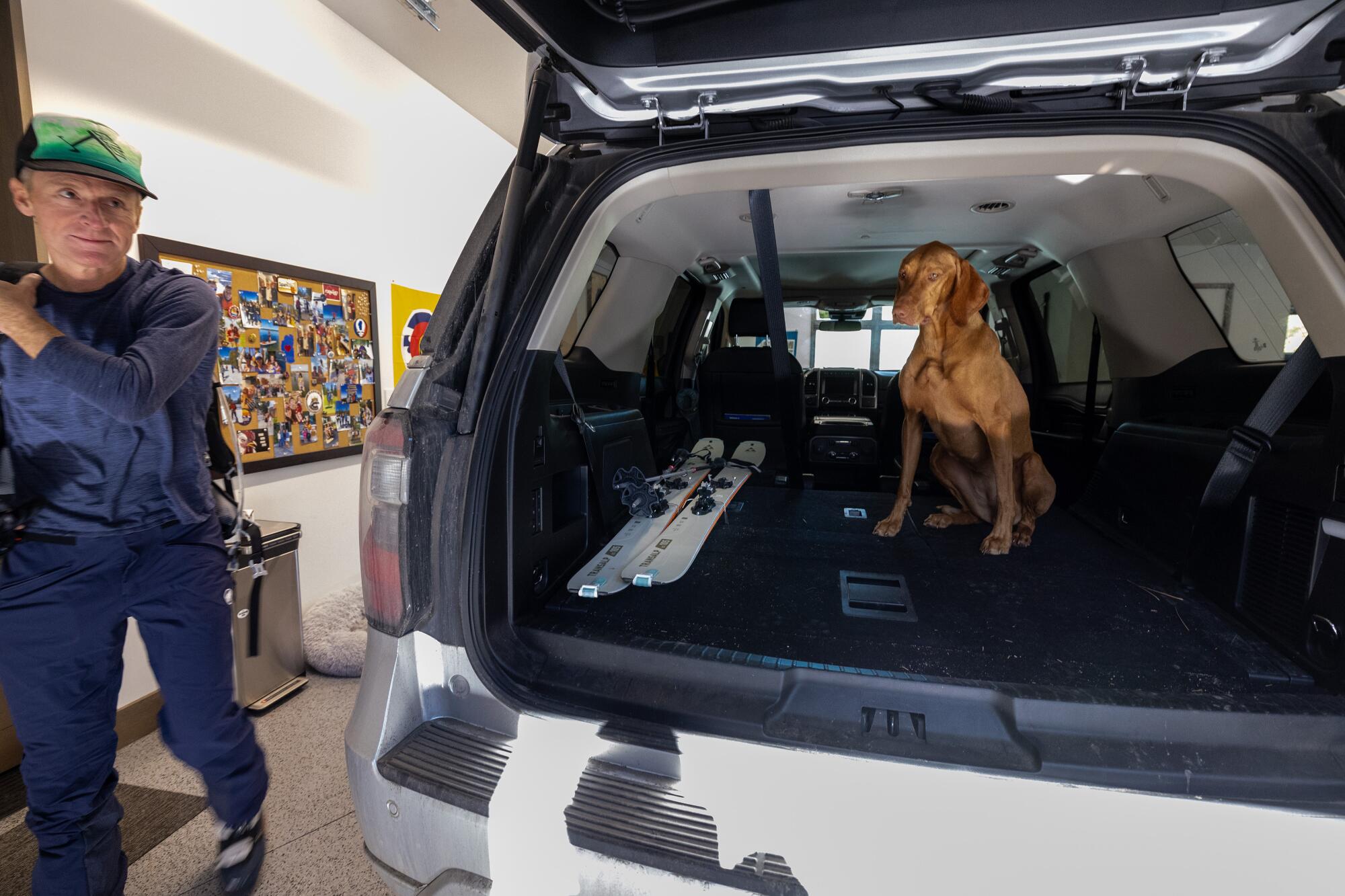
Graham Cooper loads skis into his SUV, preparing for a back-country exercise session with his loyal dog, Busy.
Ballinger’s data-driven approach and stellar track record were enough to win over Cooper.
And he has been willing to wait.
He was ready to climb Everest four years ago, but when China shut down expeditions to its side of the mountain in 2020 in response to the COVID-19 pandemic, Ballinger stuck to his principles and refused to resume climbing with the crowds in Nepal. This is the first year since the pandemic that the Chinese side has been open.
The Alpenglow team, which includes 26 clients, guides and Sherpas hoping to reach the summit, were originally scheduled to begin their expedition in late April. After a late permitting change from the Chinese government, that date has been pushed back to May 7.
Cooper has competed in the Ironman World Championship in Hawaii 11 times and has won the legendary Western States Endurance Run, a 100-mile ultra-marathon. He is not a man accustomed to sitting around. “I’m feeling ready and anxious to get going,” he texted a reporter last week.
When not trying to sleep in his hypoxic tent, Cooper has spent his training days in Tahoe on back-country skis doing laps up and down a mountain, his 3-year-old dog, a Vizsla named “Busy,” at his heels. Indoors, he straps on a hypoxic mask hooked to the same motor he uses for the sleeping tent and rides a stationary bike an hour at a time. Or climbs a StairMaster. Or throws on his mountaineering boots and a heavy backpack and trudges up and down slopes.
Why?
“I’m addicted to doing this kind of stuff,” said Cooper, who ran his first marathon when he was 13. “I just feel like a fundamentally happier person when I’m training.”
Ballinger leads clients on bucket list climbs all around the globe. Many of the treks present more interesting technical challenges than Everest. Almost all of them feel like wild outposts compared with the circus vibe on Everest’s south side.
Still, he gets poetic when he describes why so many clients are drawn to the world’s tallest summit.
“Because it’s so hard,” he said. It takes incredible fitness, mental fortitude and a heavy dose of luck to make it to the top. And no matter how many precautions you take, there’s that uncontrollable element of risk.
“It’s not just a battle for success, it’s a battle for survival up there,” Ballinger said. “That’s something that many of us have not experienced otherwise. I think that really captures people.”
Business
Studio owners revise plans for $1-billion update of historic Television City

The owners of Television City have scaled back their plans to enlarge and modernize the landmark Los Angeles studio where CBS began making shows to broadcast nationwide at the dawn of the television age.
Formerly known as CBS Television City, the studio sits next to popular tourist attractions the Original Farmers Market and the Grove shopping center in the Fairfax district where it has been operating since 1952 as a factory for such hit shows as “All in the Family,” “Sonny and Cher” and “American Idol.”
CBS sold the famous studio for $750 million in 2019 to Hackman Capital Partners, one of the world’s largest movie lot owners and operators. CBS continues to occupy Television City as a tenant.
An architect’s rendering of the planned office and production space at Television City, an entertainment studio in the Fairfax district of Los Angeles.
(Courtesy of Foster + Partners and Television City)
Hackman Capital announced a $1.25-billion plan two years ago to expand and upgrade facilities on the lot at Beverly Boulevard and Fairfax Avenue in hopes of harnessing strong demand in the region for soundstages, production facilities and offices for rent on studio lots.
Hackman Capital on Friday will update its application to the city to enhance the studio, saying it is responding to feedback about the project from nearby residents, stakeholders and city officials. If approved, the new project is expected to be completed by 2028.
The studio owners also brought in a new design architect, Foster + Partners. The London-based firm is led by Norman Foster, a prominent architect whose designs include the pickle-shaped Gherkin skyscraper in London and the master plan for the $2-billion One Beverly Hills condominium and hotel complex under construction in Beverly Hills.
Hackman Capital, which operates studios in the U.S., Canada and U.K., is also responding to changing conditions in the office rental market, which has contracted since the COVID-19 pandemic drove many companies to work remotely at least some of the time. Plans still call for creating new offices, but there would be fewer of them.
Foster’s new design eliminates a 15-story office tower on the west side of the lot, cutting 150,000 square feet of offices to rent to entertainment-related firms. Another 15-story office tower remains in the plan, but other building heights have been lowered, particularly along the perimeters, Hackman Capital said.

An architect’s rendering of plans for Television City.
(Courtesy of Foster + Partners and Television City)
The plan still represents an addition of more than 980,000 square feet to the 25-acre site at Beverly Boulevard and Fairfax Avenue that retains a suburban-style low-density appearance with soundstages, low-rise offices and support facilities flanked by asphalt parking lots.
The company’s proposal calls for combining old and new space to create 700,000 square feet of offices to support production on the lot and an additional 550,000 square feet of offices for rent to entertainment and media companies, the company said.
Office space behind studio gates is in high demand in the Los Angeles area and has been snapped up at other studios by such big Hollywood players as Netflix and Amazon.
“The industry wants to have a location where they can do production and have offices in a self-contained campus environment,” said real estate broker Jeff Pion of CBRE, who represents Hackman Capital. “Having all of the different components that make up production in one location is very attractive to the industry.”
Plans for Television City also call for a new commissary and more than four acres for production base camps. The streetscapes would be improved to be more visually appealing to passersby, with wider sidewalks.
On Fairfax Avenue, where pedestrians now pass by a fenced parking lot, there would be shops and restaurants serving the public on the ground floor of office buildings that could be reached only from inside the lot.
The separation is part of the balancing act Hackman Capital is attempting to make Television City feel more friendly to the neighborhood while retaining the security and exclusivity of a closed campus that appeals to celebrities and others who make movies and television shows.
Landlords can also charge a premium for office space on movie lots because they are close to the action for independent production companies and offer the cachet prized by many in the entertainment industry.
Filming activity in Los Angeles has fallen off substantially in the wake of strikes by writers and actors last year, according to FilmLA, a nonprofit organization that tracks on-location shoot days and filming permits in the region. The downward trend compounded a dip that emerged in late 2022 as on-location filming in Los Angeles took a dive as studios pared back movie and TV production that surged during the COVID-19 pandemic.

A rendering of the entrance to the planned mobility hub on Fairfax Avenue where shuttle buses from a nearby subway station would come and go.
(Courtesy of Foster + Partners and Television City)
California is finding it particularly hard to rebound from the strikes because it’s more expensive to shoot here, multiple production executives told The Times. That makes Los Angeles less attractive to studios looking to cut costs after major industry disruption.
To Hackman Capital Chief Executive Michael Hackman, the downturn and filming pullback from California suggest that regulators and studio operators should further support production companies.
“Our actual customers tell us all of them want to stay in Los Angeles,” he said. “We have the best crews in the world here, but we don’t have enough modern soundstages in premier locations. We also have to push the state on tax incentives so that we don’t lose business outside of the city.
“The entertainment industry is our city signature industry and if we don’t invest in the future, we’re really at risk of losing it,” Hackman said. “We’re still emerging from a once-in-a-generation dual strike. And the production stoppage cost Angelenos approximately $6.5 billion or more in lost wages and economic activity, which makes it clear how important this industry is to our city, and especially the people who work in entertainment every day.”
Hackman Capital’s proposal calls for raising the number of Television City stages to at least 15, from 8, along with production support facilities.
To make room for the planned additions, parking would be converted from surface lots to garage structures and underground spaces capable of parking 4,930 vehicles.
Two stages built in the 1990s on the east side of the lot would be demolished as part of a planned reconfiguration of the site.
The four original stages built by CBS in 1952 would be preserved along with other historical design elements created by Los Angeles architect William Pereira, who also designed such noteworthy structures as the futuristic Theme Building in the middle of Los Angeles International Airport and the Transamerica Pyramid office tower in San Francisco.
Pereira’s long-range plan for Television City conceived in the 1950s was expansive, said Bob Hale, creative director of Rios, the master plan architect of Hackman Capital’s proposed makeover. Hale said Pereira’s original concept called for the complex to grow to 24 stages and 2.5 million square feet of production space, including several multistory office buildings.
“It was built in a way that it could be disassembled and incrementally extended,” Hale said. “For a number of reasons, that didn’t happen.”
In an effort to make it happen now, Hackman Capital set out to get the support of Councilwoman Katy Yaroslavsky and the surrounding community. Over five years, the company met with nearly 3,000 neighbors, Hackman Capital said.
Among the groups supporting the project are the Holocaust Museum LA, Los Angeles Conservancy, Los Angeles/Orange Counties Building and Construction Trades Council, Mid City West Neighborhood Council and FilmLA, Hackman Capital said.
The first proposal drew fire from neighboring businesses the Grove and Farmers Market, which sent letters to residents in 2022 calling the Television City project a “massively scaled, speculative development which, if approved, would overwhelm, disrupt, and forever transform the community.”
In July 2022, an executive representing Grove owner Rick Caruso appeared before a committee of the Mid City West Neighborhood Council and said the Television City project would create “complex” issues for the neighborhood, including traffic, parking and construction. Caruso himself has said he does not oppose the redevelopment of Television City.
The Beverly Fairfax Community Alliance, which was founded by the Grove and Farmers Market, has been more blunt, warning that the expanded site would clog Fairfax Avenue, Beverly Boulevard, La Brea Avenue and 3rd Street with traffic.

The signature red awning at Television City as seen from Beverly Boulevard.
(Courtesy of Foster + Partners and Television City)
“Even those accustomed to living with L.A. traffic and parking nightmares will be shocked at how much worse it can be,” the group said on its website.
To address such concerns, Hackman Capital said the new plan will reduce the number of estimated daily car trips to Television City by 5,000 to 8,700. The landlord also plans to move its “mobility hub” from The Grove Drive on the east side to Fairfax at 1st Street on the west side of the lot. The mobility hub would serve public transit, rideshares and other passenger drop-offs as well as employee shuttle buses to the subway stop being built at Fairfax and Wilshire Boulevard.
“Our goal with Television City, particularly along the perimeter on our public edges, was to find a really great interface with the community. So it wasn’t just a studio with a blank wall, but we were active and engaged,” said Brian Glodney, a development executive for Hackman Capital.
Community members told Hackman Capital said they want the streets outside the studio to have a sense of connection between mom-and-pop businesses on Fairfax, the Farmers Market, the Grove and Pan Pacific Park, Glodney said.
Outlets on the edge of the lot such as shops and restaurants will be limited to a total of 20,000 square feet, he said, “just enough to help activate the streets but not compete with our neighbors.”
Business
Angelina Jolie blames Brad Pitt’s NDA for scuttling winery sale, alleges abuse before plane altercation
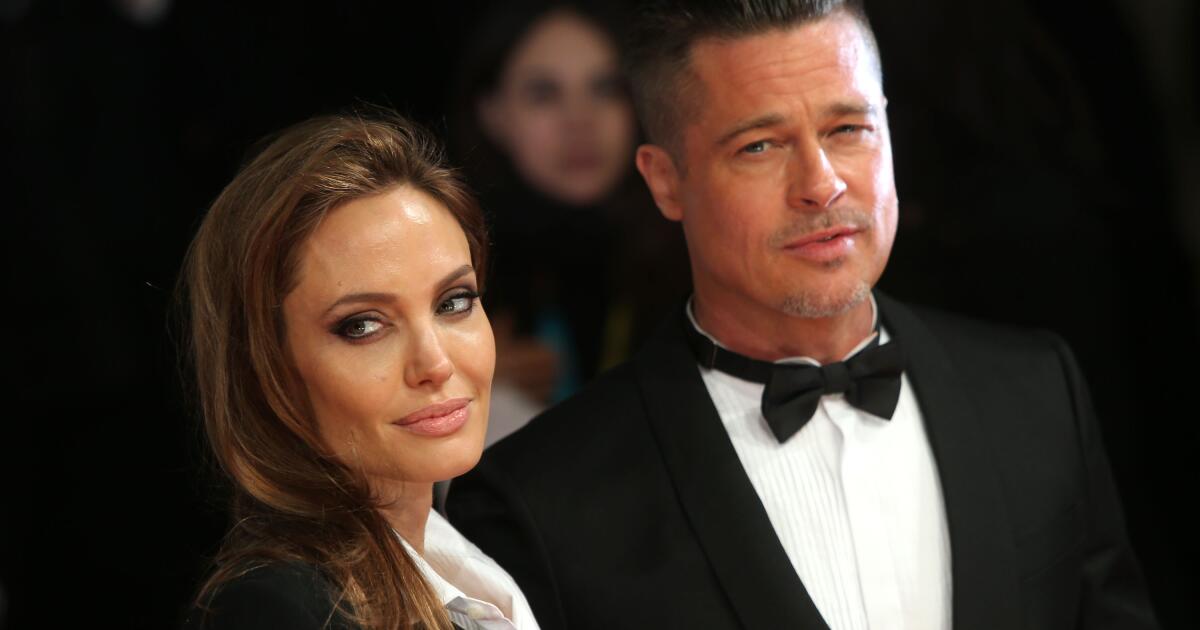
Angelina Jolie’s legal team filed a motion Thursday to acquire Brad Pitt’s communications stemming from an “all-encompassing” nondisclosure agreement he wanted that purportedly tanked the sale of his ex-wife’s share of their Chateau Miraval winery to him.
The former Hollywood power couple’s protracted legal dispute over the winery — and its legacy for their six children — took another turn as Jolie’s team asked a judge to compel Pitt and his company, Mondo Bongo, to produce documents pertaining to his calling for a “more onerous NDA” in order to purchase Jolie’s share of the south-of-France winery.
The documents Jolie seeks, according to the Thursday filing in Los Angeles County Superior Court, are “highly relevant” and also likely to yield admissible evidence in the case, her team argued.
Her attorney, Paul Murphy, also accused the “Once Upon a Time … in Hollywood” Oscar winner of “unrelenting efforts to control and financially drain” Jolie, as well as “attempting to hide his history of abuse, control, and coverup.”
An attorney and a publicist for Pitt declined to comment Thursday on the new filing and allegations of prior abuse.
Pitt has accused Jolie and her company, Nouvel, of secretly selling her share of their winery and family home to “seize profits she had not earned and returns on an investment she did not make.” He claimed in a February 2022 lawsuit and subsequent amended complaints that his investment in the business “exceeded Jolie’s by nearly $50 million” and that Jolie had reneged on exclusive buyout negotiations they had agreed on in early 2021, when she originally said she wanted out of the business.
Pitt has been seeking a jury trial and the undoing of Jolie’s October 2021 sale to the Tenute del Mondo wine group, a subsidiary of the Stoli Group.
In October 2022, Jolie filed a cross-complaint that argued that the couple had no agreement regarding two-party consent to the sale of either party’s interest in the property. She also detailed allegations of abuse that prompted her to file for divorce from Pitt in 2016, ending their two-year marriage and much-talked-about 10-year romantic relationship. (The actors, although legally unmarried since 2019, have not yet finalized their drawn-out divorce.)
The “Inglourious Basterds” star has also complained that he can no longer enjoy his private residence in France, as it is now co-owned by strangers; Jolie contended Thursday that she and their children have not returned to the French estate since leaving it and boarding the fateful September 2016 flight that precipitated Jolie filing for divorce five days later.
In Thursday’s motion to compel, reviewed by The Times, attorneys for the “Girl, Interrupted” Oscar winner asked again for responses from Pitt to help them figure out his reason for pulling out of their implied agreement for him to buy Jolie’s stake in the winery. Pitt’s decision to pull out of the sale, her attorney said, “nearly broke” Jolie.
“If that sale had been completed, this lawsuit never would have happened. But at the last minute, Pitt ‘stepped back’ from his agreement to buy Jolie’s interest in Miraval, and the deal collapsed. The question at the heart of this case — and at the center of this motion — is why,” the motion said.
The answer, her attorney said, has to do with sealed documents Jolie submitted in the ex-couple’s separate but simultaneous custody dispute. The new filing referred to sealed March 2021 documents — titled “Testimony Regarding Domestic Violence” — that “apparently enraged Pitt” and led to him “stepping back” from the sale.
“When Jolie filed the evidence in the custody suit, she was careful to file it under seal so that no member of the public could see it. But Jolie’s sealed filing, which included emails, summaries of the family’s expected testimony, and other evidence, caused Pitt to fear that the information could eventually become public,” the document said.
Pitt then decided he could no longer rely on Jolie’s voluntary efforts to keep things private and demanded that she “contractually bind herself to that silence,” her filing said.
With that, her team indicated there was abuse of Jolie that predated the contentious 2016 private-plane flight. In referring to that sealed filing in the custody case — as well as another titled “Testimony of Minor Children” — her team argued that Pitt tried to force a more sweeping NDA on Jolie to conceal his alleged “personal misconduct, whether related to Miraval or not.”
Her team is seeking Pitt’s communications with the FBI, U.S. attorney’s office, the L.A. County Department of Children and Family Services and the Los Angeles Police Department regarding the private flight. She is also seeking information from DCFS about its investigation, drug and alcohol testing and a safety plan the agency purportedly required Pitt to undertake to address his conduct.
“While Pitt’s history of physical abuse of Jolie started well before the family’s September 2016 plane trip from France to Los Angeles, this flight marked the first time he turned his physical abuse on the children as well,” the new motion states.
According to an exhibit on a 2024 court declaration by Jolie attorney Murphy, an offer to turn over many of the communications requested by Jolie’s team was rejected last month by attorney Stella Chang, who told a Pitt attorney via email that his “proposal does not come anywhere close to providing the documents responsive to [the team’s requests], which Ms. Jolie needs to defend herself from Mr. Pitt’s frivolous allegations.”
Pitt was never charged in connection with the plane incident, either by the U.S. attorney’s office or the Department of Children and Family Services, which investigated the incident — and its allegation of child abuse — before the FBI got involved. The FBI decided in November 2016 to close its probe without filing any charges against the actor. People magazine reported that he was drunk during the incident, which “escalated more than it should have,” and asserted that “no one was physically harmed.”
Jolie never pressed charges, the filing said, “as she believed the best course was for Pitt to accept responsibility and help the family recover from the post-traumatic stress he caused.” It also alleged that Pitt refused to seek domestic violence counseling.
Pitt, in a 2017 GQ interview, admitted he had a drinking problem — saying, “I was boozing too much” — but said he was now sober. He said he was going to therapy after first going through two therapists who didn’t work out, and lamented his and Jolie’s marital woes being dragged out and misconstrued by the media with no “delicacy or insight.” Pitt has never argued that his behavior on the 2016 flight was acceptable.
His legal team said in a June 2023 court filing that while Jolie had backed out of the winery sale, purportedly over “restrictive language” requested in a mutual nondisclosure agreement, a year later she proposed an even broader NDA in their divorce case that would have required that “[o]ther than in court pleadings or testimony, neither party shall directly or through a party’s representatives make in a public forum any derogatory remark about the other party.”
The “Thelma & Louise” actor alleged in court documents that Jolie decided to sell her Miraval stake to the Stoli subsidiary after receiving an “adverse custody ruling” in their protracted divorce proceedings.
Pitt’s legal team last summer claimed that Jolie “vindictively” sold her stake in the winery behind his back and alleged that she “sought to inflict harm on Pitt,” subsequently revealing more details about the unraveling of the couple’s relationship. Jolie’s camp at the time insisted — and continues to do so in the new filing — that Pitt refused to complete a Miraval sale with Jolie “unless she agreed to being silenced” about his alleged abuse.
Now her team is claiming that Pitt attempted to cover up the alleged abuse by objecting to the children testifying on their custody preferences. The filing includes a May 2021 text message from Jolie to a friend (as an exhibit) relaying that she tried to sell the winery to Pitt per their agreement but that he was “really not being fair” and demanding “a lot of punishing restrictions.” The filing also outlined for the first time the language of the “more onerous NDA.”
Said restrictions, per the motion, were put forth in an “expansive” NDA that stated that the parties could not make any statements or take actions that would “disparage, defame, or compromise the goodwill, name, brand or reputation of Miraval Provence or any of its affiliated or direct and indirect shareholders,” including Jolie, Pitt, Pitt’s business partner and good friend Marc Perrin, and Familles Perrin SAS.
It also stated that the parties could not “commit any other action that could likely injure, hinder or interfere with the Business, business relationships or goodwill of Miraval Provence, its affiliates, or its direct and indirect shareholders.” Jolie refused to sign it, and “by June 3, 2022, the deal was dead,” the motion said.
Pitt’s NDA in the failed winery deal would have required, according to 2023 court documents filed by his legal team, that “[a]t no time for a legally binding period of four (4) years following the Closing Date, and, on a good faith basis, any period thereafter, shall the Parties (i) make any statements, or take any other actions whatsoever, to disparage, defame, or compromise the goodwill, name, brand or reputation of Miraval Provence or any of its affiliates or direct and indirect shareholders,” including Jolie, Perrin, Familles Perrin SAS and Pitt, who has been the celebrity face of the winery, so as not to hurt or hinder the business.
Jolie accused Pitt of gaslighting her and, according to the new documents, signed a power of attorney at that point authorizing her European lawyer, Laurent Schummer, to take over the sale process.
“Mr. Pitt refused to purchase Ms. Jolie’s interest when she would not be silenced by his NDA,” Jolie attorney Murphy, managing partner at the law firm Murphy Rosen LLP, said Thursday in a statement to The Times.
“By refusing to buy her interest but then suing her, Mr. Pitt put directly at issue why that NDA was so important to him and what he hoped it would bury: his abuse of Ms. Jolie and their family. After eight months of delays, this motion asks the Court to force Mr. Pitt to finally produce that evidence.”
A person close to Jolie who was not authorized to speak publicly about the case told The Times that Pitt “is drawing all this out of Angelina.”
“She does not want to be here, she does not want to be raising any of these facts, and she is doing it only because Pitt’s lawsuit against her is forcing her to defend herself. It’s incredibly sad and she just wishes he could move on and let her be,” the person said.
The person added that Jolie’s lawyers have emails, photos and testimony that was presented under seal in the custody case that would help her in this matter. However, the person said, if the case goes to trial, she “will be forced to use that evidence in the trial whether she wants to or not.”
Times assistant editor Christie D’Zurilla contributed to this report.
-

 Kentucky1 week ago
Kentucky1 week agoKentucky first lady visits Fort Knox schools in honor of Month of the Military Child
-

 News1 week ago
News1 week agoIs this fictitious civil war closer to reality than we think? : Consider This from NPR
-

 World1 week ago
World1 week agoShipping firms plead for UN help amid escalating Middle East conflict
-

 Politics1 week ago
Politics1 week agoICE chief says this foreign adversary isn’t taking back its illegal immigrants
-

 Politics1 week ago
Politics1 week ago'Nothing more backwards' than US funding Ukraine border security but not our own, conservatives say
-

 News1 week ago
News1 week agoThe San Francisco Zoo will receive a pair of pandas from China
-

 World1 week ago
World1 week agoTwo Mexican mayoral contenders found dead on same day
-

 Politics1 week ago
Politics1 week agoRepublican aims to break decades long Senate election losing streak in this blue state















